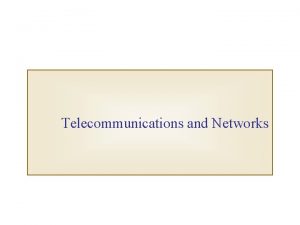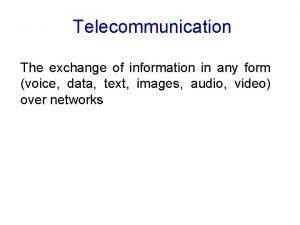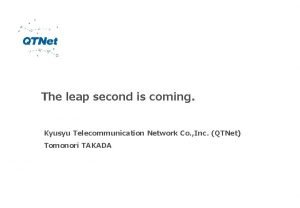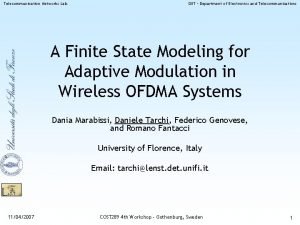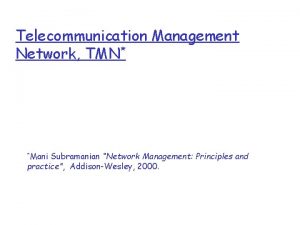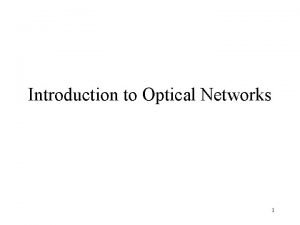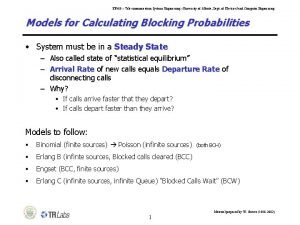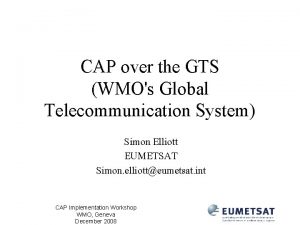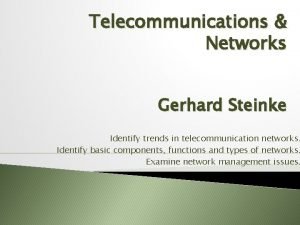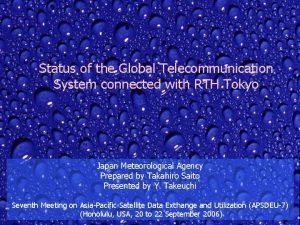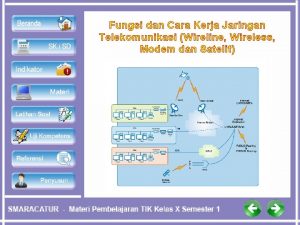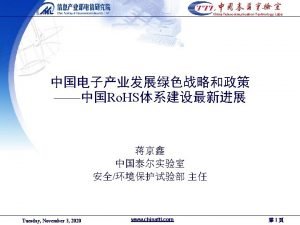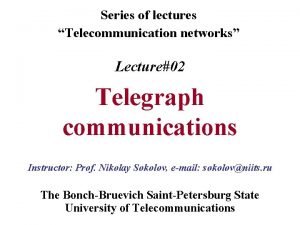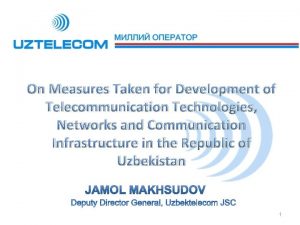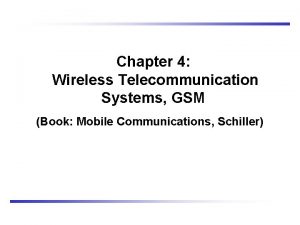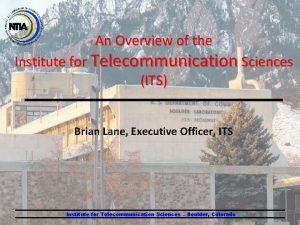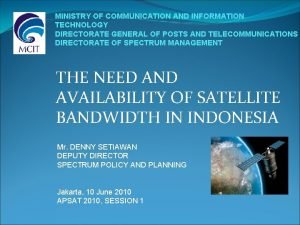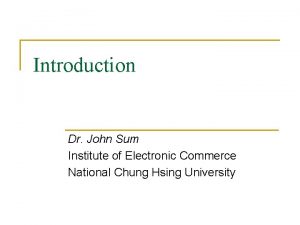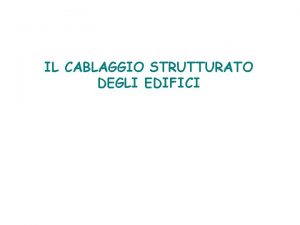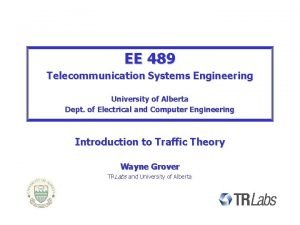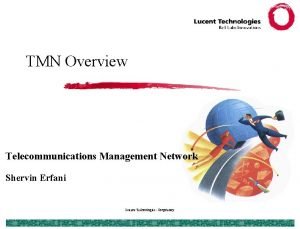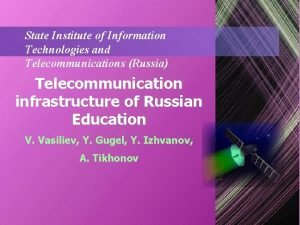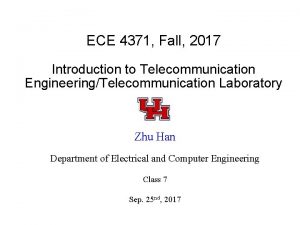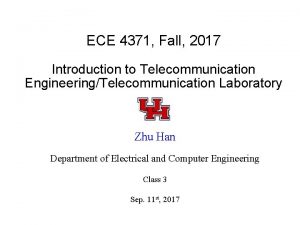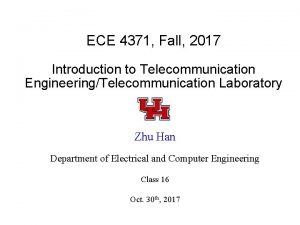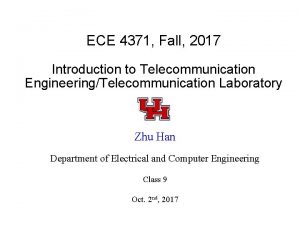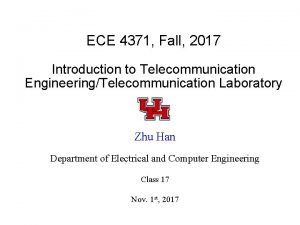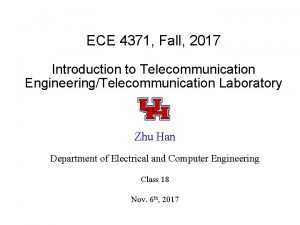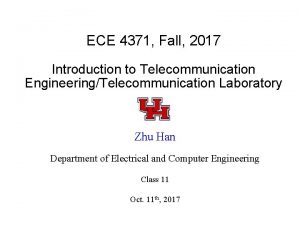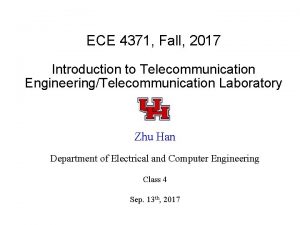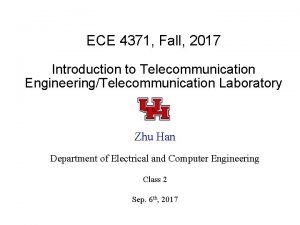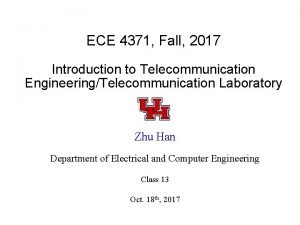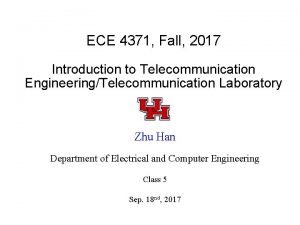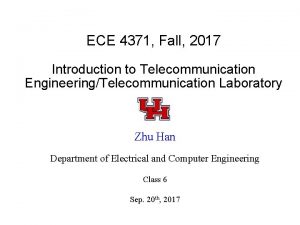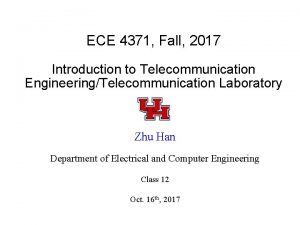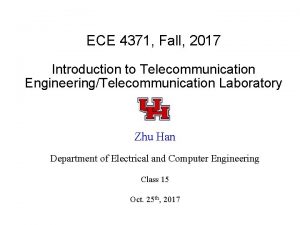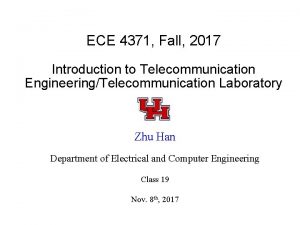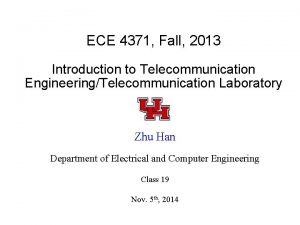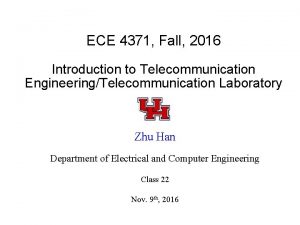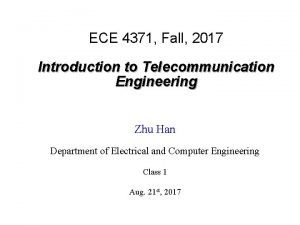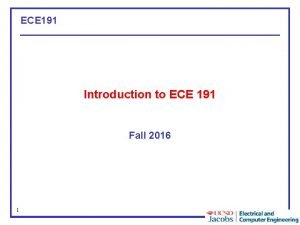ECE 4371 Fall 2017 Introduction to Telecommunication EngineeringTelecommunication






























- Slides: 30

ECE 4371, Fall, 2017 Introduction to Telecommunication Engineering/Telecommunication Laboratory Zhu Han Department of Electrical and Computer Engineering Class 10 Oct. 4 th, 2017

Outline l Line Coding Spectrum l Inter-Symbol-Interference l Nyguist Three Criteria l Midterm review

Basic steps for spectrum analysis l Figure – Basic pulse function and its spectrum P(w) u For example, rect. Function (in time) is sinc function (in freq. ) – Input x is the pulse function with different amplitude Carry different information with sign and amplitude u Auto correlation is the spectrum of Sx(w) u – Overall spectrum x

Digital Communication System l Spectrum of line coding: – Basic pulse function and its spectrum P(w) u For example, rect. function is sinc – Input x is the pulse function with different amplitude u u Carry different information with sign and amplitude Auto correlation is the spectrum of Sx(w) – Overall spectrum

NRZ l R 0=1, Rn=0, n>0 l Pulse width Tb/2 l P(w)=Tb sinc(w. Tb/2) l Bandwidth Rb for pulse width Tb

RZ scheme l DC Nulling l Split phase

l l Polar biphase: Manchester and differential Manchester schemes In Manchester and differential Manchester encoding, the transition at the middle of the bit is used for synchronization. The minimum bandwidth of Manchester and differential Manchester is 2 times that of NRZ. 802. 3 token bus and 802. 4 Ethernet

Bipolar schemes: AMI and pseudoternary l R 0=1/2, R 1=-1/4, Rn=0, n>1, l Reason: the phase changes slower

Multilevel: 2 B 1 Q scheme l NRZ with amplitude representing more bits EE 541/451 Fall 2006

Pulse Shaping l Sy(w)=|P(w)|^2 Sx(w) – Sx(w) is improved by the different line codes. – p(t) is assumed to be square l How about improving p(t) and P(w) – – – Reduce the bandwidth Reduce interferences to other bands Remove Inter-symbol-interference (ISI) In wireless communication, pulse shaping to further save BW Talk about the pulse shaping later

Small questions in exam 2 l Draw the spectrums of three different line codes and describe why the spectrums have such shapes.

ISI Example sequence sent 1 0 1 sequence received 1 1(!) 1 Signal received Threshold t 0 -3 T -2 T -T 0 T 2 T 3 T 4 T Sequence of three pulses (1, 0, 1) sent at a rate 1/T 5 T

Baseband binary data transmission system. l ISI arises when the channel is dispersive l Frequency limited -> time unlimited -> ISI l Time limited -> bandwidth unlimited -> bandpass channel -> time unlimited -> ISI p(t)

ISI l l First term : contribution of the i-th transmitted bit. Second term : ISI – residual effect of all other transmitted bits. l l We wish to design transmit and receiver filters to minimize the ISI. When the signal-to-noise ratio is high, as is the case in a telephone system, the operation of the system is largely limited by ISI rather than noise.

ISI l Nyquist three criteria – Pulse amplitudes can be detected correctly despite pulse spreading or overlapping, if there is no ISI at the decisionmaking instants 1: At sampling points, no ISI u 2: At threshold, no ISI u 3: Areas within symbol period is zero, then no ISI u – At least 14 points in the finals u u 4 point for questions 10 point like the homework

1 st Nyquist Criterion: Time domain p(t): impulse response of a transmission system (infinite length) p(t) 1 shaping function 0 t Equally spaced zeros, -1 interval no ISI !

1 st Nyquist Criterion: Time domain Suppose 1/T is the sample rate The necessary and sufficient condition for p(t) to satisfy Is that its Fourier transform P(f) satisfy

1 st Nyquist Criterion: Frequency domain (limited bandwidth)

Proof Fourier Transform At t=T

Proof

Sample rate vs. bandwidth l W is the bandwidth of P(f) l When 1/T > 2 W, no function to satisfy Nyquist condition. P(f)

Sample rate vs. bandwidth l When 1/T = 2 W, rectangular function satisfy Nyquist condition

Sample rate vs. bandwidth l When 1/T < 2 W, numbers of choices to satisfy Nyquist condition l A typical one is the raised cosine function

Cosine rolloff/Raised cosine filter l Slightly notation different from the book. But it is the same : rolloff factor if

Raised cosine shaping l Tradeoff: higher r, higher bandwidth, but smoother in time. P(ω) r=0 r = 0. 25 r = 0. 50 r = 0. 75 r = 1. 00 p(t) 2 w W ω 0 0 ECE 4371 Fall 2008 t

Figure 4. 10 Responses for different rolloff factors. (a) Frequency response. (b) Time response.

Cosine rolloff filter: Bandwidth efficiency l Vestigial spectrum 2 nd Nyquist (r=1) r=0

2 nd Nyquist Criterion l Values at the pulse edge are distortionless l p(t) =0. 5, when t= -T/2 or T/2; p(t)=0, when t=(2 k-1)T/2, k≠ 0, 1 -1/T ≤ f ≤ 1/T

Example

3 rd Nyquist Criterion l Within each symbol period, the integration of signal (area) is proportional to the integration of the transmit signal (area)
 Difference lan wan
Difference lan wan 2017 dvhimss annual fall conference
2017 dvhimss annual fall conference Telecom risk management
Telecom risk management Objectives of telecommunication
Objectives of telecommunication Types of telecommunication networks
Types of telecommunication networks It means communication at a distance
It means communication at a distance Kyushu telecommunication network co.,inc.
Kyushu telecommunication network co.,inc. Telecommunication
Telecommunication Tmn function block: a) osf b) mf c) wsfe d) nef e) qaf
Tmn function block: a) osf b) mf c) wsfe d) nef e) qaf Swift finance retrievals
Swift finance retrievals Telecommunications network architecture
Telecommunications network architecture Telecommunication
Telecommunication Global telecommunication system
Global telecommunication system Trends in telecommunication
Trends in telecommunication Global telecommunication system
Global telecommunication system Itu world telecommunication indicators database
Itu world telecommunication indicators database Jaringan wireline adalah
Jaringan wireline adalah China telecommunication technology labs
China telecommunication technology labs Telecommunication
Telecommunication Telecommunication sealing technology
Telecommunication sealing technology Bsc and msc in telecom
Bsc and msc in telecom Institute for telecommunication sciences
Institute for telecommunication sciences World telecommunication standardization assembly
World telecommunication standardization assembly Ministry of telecommunication
Ministry of telecommunication Types of telecommunication networks
Types of telecommunication networks Telecommunication
Telecommunication Cablaggio verticale edifici
Cablaggio verticale edifici University of alberta
University of alberta Telecommunication management network
Telecommunication management network Telecommunication sealing technology
Telecommunication sealing technology Telecommunication system architecture with diagram
Telecommunication system architecture with diagram



